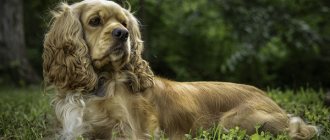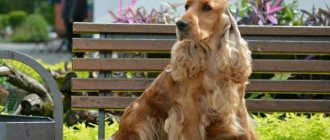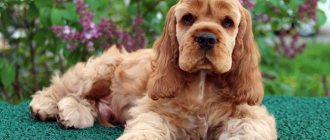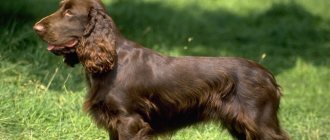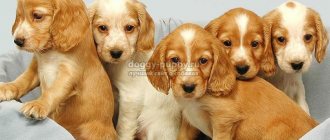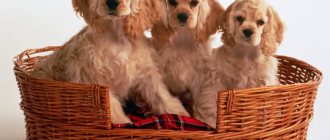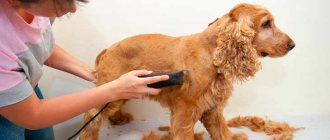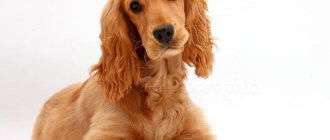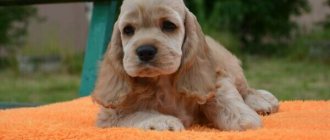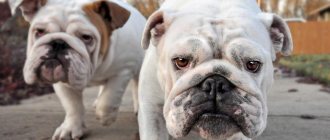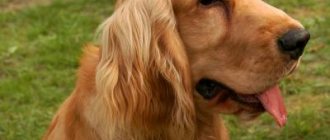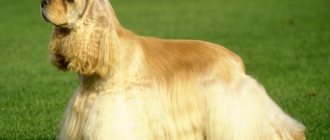Spaniels are a large group of breeds that include both hunting and decorative and even dwarf dogs.
Cocker spaniels are dogs bred exclusively for hunting.
But over time, the popularity of the breed grew and people of all ages and professions began to have its representatives as companions, faithful companions and devoted friends.
Increasingly, cocker spaniels are becoming not hunters, but full members of the family and winners of dog shows.
Origin story and what it looks like in the photo
The first mention of spaniels dates back to around the 16th century, and the name of the breed comes from the word espaigneul, which meant “Spanish dog” in Old French..
Despite this, there is no consensus about the homeland of these dogs. There are several versions of the origin of spaniels: Greek, Spanish, German, Irish; descriptions of similar animals were found in artifacts of the Cypriot and Egyptian civilizations.
The final formation of the breed of hunting cocker spaniels is the merit of British breeders. It was in England in the 19th century. a male named Obo gave birth to offspring with endurance, hunting instincts and courage.
The primary purpose of these dogs was to hunt small birds and animals; it was the hunting instinct, activity and ability to lift birds from water and land that determined the popularity of English cockers.
The first exhibition at which English cocker spaniels were presented was held in 1859 in Birmingham, but the breed was not recognized as an independent breed until 1892, when it was registered by the English Kennel Club.
The breed was officially registered with the FCI only in 1902.
Until 1990, the breed standard adhered to strict limits and individuals with even minor deviations were rejected, excluded from breeding and were not able to participate in exhibitions.
A little later, the standard was relaxed and now cocker spaniels are used not only for hunting, but also as companions.
Photo
We invite you to get acquainted with the appearance of the English Cocker Spaniel breed, photos of which are presented below.
England of the 19th century is known not only for its industrial and cultural achievements; the cocker spaniel bred in this country can rightfully be attributed to them. This active hunting dog immediately became everyone's favorite. From the photo, the kind and insightful eyes of a lively, cheerful, energetic animal look at us. The Cocker will never let its owners get bored, involving them in real adventures during ordinary walks.
The English Cocker Spaniel is a hunting dog, but in our realities, when few people manage to go hunting, this breed is a godsend for people who love an active lifestyle. They will always be on the same page with their cocker dog.
Admire the harmonious physique of spaniels, their shiny coat, touching ears, intelligent look, which reflects irrepressible energy, curiosity and willingness to follow the owner anywhere.
Interesting Facts
- The name "cocker" comes from the English word "woodcock" - forest bird (woodcock). It was this feathered game that was hunted by the first representatives of the breed.
- These dogs are often used by law enforcement agencies to search for drugs and other illegal substances.
- The writer Mikhail Prishvin had 4 spaniels.
- The children's book “Tomka” by Evgeny Charushin is dedicated to a spaniel puppy.
Description and standard
English cocker spaniels are dogs with a harmonious build; they have a squat, compact, proportionally built body with well-developed muscles..
Representatives of this breed are very graceful; they move at a light gallop, smoothly and gracefully, as if without touching the surface with their paws.
According to the official standard they have:
- oval head with a pronounced transition to an almost square muzzle;
- scissor bite;
- limbs are straight, strong, with well-developed muscles, well covered with hair;
- the back is straight, the croup is massive and short;
- chest of moderate depth;
- the ears are oval, long and wide, hanging, set low, close to the head, the base of the auricle is located at eye level, the outer side is covered with wavy thick hair;
- the eyes are round, shallow-set, but not bulging, the iris is dark brown;
- the nose is oval, pigmented black, the nostrils are wide;
- The tail is saber-shaped, set below the level of the back, docked, but can also have a natural length to the hocks, since this procedure is prohibited in a number of countries.
The coat of English Cocker Spaniels is thick, close-lying, soft and silky . Can be straight or slightly wavy, but not curly. The undercoat is dense and well developed.
English Cocker Spaniel training
Hunting with an English Cocker Spaniel
In modern conditions, the “English” are gradually changing their qualifications, increasingly turning into sporting dogs and playful companions. However, the hunting instincts of the breed do not suffer from this situation. English cocker spaniels can work with both swamp and field or even upland game. However, taking into account the fact that each type of bird has its own odor, varying in intensity, it is unlikely to be possible to train a dog on both snipe and black grouse at once. Experienced owners recommend starting to introduce your pet to hunting with a wading bird. According to observations, a dog that deftly handles great snipes performs just as well when working with quails. At the same time, dogs, accustomed to lifting only wild animals onto their wings, slow down and get lost in wetlands.
The English Cocker Spaniel begins to be trained from an early age and in a playful way. For example, you can tie a bird's wing to a string and twitch it in front of a 3-month-old puppy's nose. The surprised animal will immediately try to grab the animated bunch of feathers, and your task is to allow him to do this. Just do not allow the puppy to chew the “prey”, since this habit will later be transferred to real hunting trophies. At 4 months, babies are trained to search for and present objects. The dog is allowed to sniff the bird carcass, after which they hide it in a secluded place and offer to find the missing one. At first, you can use hints - a hand gesture in the direction of an object or a deliberately created draft that carries the smell of game throughout the apartment.
Commands “Come to me!” and “Nearby!” in hunting dogs they must be practiced to the point of automatism, therefore the OKD completed before training is only beneficial for the English cocker. Another important skill is indifference to shots, which is the most difficult for the “English”. They begin to accustom their pet to the sharp sounds and smell of gunpowder in the field. First, shots are fired at a distance (the optimal distance is 150 m) and only after the dog gets used to the noise, the gap between the shooter and the animal is gradually reduced.
Important: in order to develop a clear understanding of your requirements and compliance in your English Cocker Spaniel, use only one prohibitive command out of several possible ones. Do not disorient the dog with the word “Ugh!” if before that he only heard from you “No!”
It is better to start getting acquainted with swamp game with great snipes, which fly quite low and heavily. Swamp hens are also a good target for an inexperienced cocker. In upland hunting, the optimal target will be a brood of grouse. As a rule, English cocker spaniels are not involved in working with waterfowl, but if you wish, it is also possible to train your pet for this type of game. Wait until mid-July, when the ducklings are grown but not fully fledged, and begin training. Well, an option for the most seasoned is hare hunting. Why specifically for the aged? Because spaniels love to chase their long-eared dogs aimlessly, in 99% of cases leaving the owner without prey.
Character traits
Cocker spaniels are playful, responsive and cheerful dogs . Being active and sharp hunters, at home they are the embodiment of kindness and tenderness. They need love, attention and care.
Representatives of this breed are very good-natured and affectionate towards all family members, but, as a rule, they choose one person as the owner and remain faithful to him throughout his life, trying to always stay close and participate as much as possible in his life.
Such excessive attachment can lead to a loss of independence and an absolute inability to be alone.
Quiet and timid individuals are extremely rare among cockers; most often these dogs are sociable and inquisitive. At the same time, they are wary of strangers and loud barks notify their owners about the visit of strangers, which indicates a good guard instinct.
Despite the stubbornness inherent in these dogs and the habit of acting independently, they are smart, flexible and strive to please the owner, so there are no problems with their upbringing and training.
Expert opinion
Kozhevin Semyon Kirillovich
Expert dog handler.
Representatives of this breed are characterized by a strong attachment to their owner. They need his undivided attention and constant communication. If these traits are encouraged, the pet may completely lose independence and even a short stay alone will cause him suffering. It is important to remember this when raising a cocker, and to train him to have self-control and understanding that the owner cannot be around all the time.
Advantages and disadvantages
When thinking about buying a puppy, you should carefully read the advantages and disadvantages of the breed - this will help you make the right, informed decision.
The advantages of cocker spaniels include::
- activity;
- devotion;
- developed hunting and guard instincts;
- ability to get along with children;
- courage and endurance;
- playful disposition;
- mind;
- sociability;
- agreeableness;
- learning ability
Negative qualities of the breed:
- need for constant attention and communication;
- the need for active long walks;
- hyperactivity;
- tendency to obesity;
- heavy shedding;
- loud barking for any reason;
- stubbornness.
In addition, English Cocker Spaniels require careful and quite labor-intensive care for their ears and coat.
Puppies
There are no cuter creatures than English Cocker Spaniel puppies. No one is left indifferent by the “skirt” - ears, movable tail, trusting look.
Usually puppies go to a new home at the age of 1.5 months. In the first days it is better not to leave the little cocker alone, otherwise he will be stressed. You need to lift the puppy with both hands; they are so mobile that they can break out of your hands and fall.
Puppies are inquisitive and tireless, they are champions in climbing onto a high sofa, armchairs, table, their courage knows no bounds: every now and then they strive to jump from there.
As for the rules in the house, you cannot make allowances for the fact that in front of you is a small, unintelligent creature. For puppies, the same prohibitions should apply as for an adult dog: for example, do not sleep in the owner’s bed, jump with their paws on a person, especially children, you should not be allowed to play even with old house slippers, otherwise you will wonder why the cocker disheveled your new shoes .
English Cocker Spaniel puppies are a special little world; what goes around comes around. Attention, care and love can make them loyal companions and protectors.
Color variations
Cocker Spaniels have a variety of coat colors: they can be solid, spotted, tri-colored or speckled . Most often there are individuals with a coat of a solid monochromatic color.
Red or golden
Most often, the red coat color is monochromatic, but can be observed in the form of tan on other, darker colors. Pigmentation is brown or black.
Black
The coat is a solid jet black color , the nose, eyelids and claws are also pigmented black . This color is considered dominant. Possible red tan.
White
A solid snow-white color is extremely rare . Not all judges recognize this coat color of Cocker Spaniels as corresponding to the breed standard, so pure white dogs rarely take prizes.
Chocolate
Recessive trait. The coat is chocolate-colored, varying in color from milkier to richer dark chocolate. Pigmentation is brown. Possible subtle red or golden tan.
Brown
The coat is dark brown or walnut in color. The eyelids and nose are black or colored to match the coat.
Breed characteristics
| Short description | |
| Origin: | Russia |
| Conditions of detention: | House with or without garden, apartment |
| Purpose: | Hunting dog, companion dog |
| Color: | Solid solid black, tan or chocolate brown, white markings acceptable |
| Wool length: | Long |
| Adult dog size: | Female height – 36-42 cm, male height – 38-44, weight – 15-20 kg |
| Average life expectancy: | 10-12 years |
| Walk: | Need active walking twice a day |
| Physical activity needs: | High physical activity needs (1.5-2.5 hours of walking or training) |
| Classification of the Russian Cynological Federation (RKF): | Group 8: Retrievers and Gun Dogs, Section 2: Gun Dogs |
| Puppy price: | From 3,000 to 20,000 rubles. Without pedigree – 3000-5000 rubles, pet class – 10000 rubles, breed class – 15000 rubles, show class – 20000 rubles |
Is he good with children and does he get along with other pets?
Being active, good-natured and friendly dogs that are not prone to aggression, Cocker Spaniels even get along well with small children and enjoy spending time playing with them.
NOTE!
It is important to remember that these dogs are jealous of their things, especially toys, so you should explain to the child that you cannot take them away from the dog.
These dogs are born hunters and it is impossible to wean them from this . They see birds, rodents and cats only as prey and will always chase them.
If raised correctly, cockers can get along with cats, but only if they grew up together.
Briefly about character and temperament
Spaniels have an active and lively temperament, they are friendly towards people and are very good with children.
Representatives of different breeds may have different attitudes towards other pets.
But with proper upbringing and timely socialization, spaniels can easily get along with other dogs, cats and other living creatures, with the possible exception of birds and small rodents.
They are loyal and obedient pets to their owners, distinguished by their intelligence, intelligence and good learning ability..
When hunting, spaniels work with interest and confidence: they are good at finding prey by instinct or by following a scent, and after shooting they present it to the hunter.
How to properly care
Like representatives of other breeds, cocker spaniels need regular hygiene procedures, which should be taught to the puppy from an early age. The ears and coat of these dogs require especially careful care.
Wool and bathing
Cocker spaniels need to be brushed daily - this eliminates the possibility of matting of the coat and the appearance of tangles, and also helps to get rid of dead hair, which is especially important during seasonal shedding..
Grooming also involves regular haircuts and trimming. Having certain skills and experience, you can do them yourself, but it is better to contact a professional groomer.
CAREFULLY!
You can't cut the guard hair - after that it will lie incorrectly. You can only trim the hair on the tips of the ears, chest and paws.
You need to bathe your pet as it gets dirty, but at least once every 2 months - washing makes the coat of these dogs more beautiful and silky, while the skin does not dry out, since it is adapted to water.
For washing, you should use a special shampoo intended for long-haired dogs, and after bathing, you should thoroughly dry the dog's hair with a towel and hairdryer..
Eyes
Every 2-3 days, wipe with a cotton pad soaked in chamomile infusion and tea leaves.
Ears
Clean your ears weekly using a cotton swab and a special product, removing accumulated wax and dirt.
Every 2-3 months it is necessary to carefully trim the inside of the ear to improve ventilation.
Claws
With regular active walks on asphalt, the claws wear down on their own. In winter or if the pet often walks on non-hard surfaces, this does not happen and the claws must be trimmed with a guillotine nail clipper every 3-4 weeks.
Teeth
Brush with a special toothbrush and toothpaste every 2-3 days, and also give your pet chewable treats and toys that help mechanically clean the teeth of plaque and stones.
Maintenance and care
Grooming an English Cocker Spaniel
English Cocker Spaniels feel most comfortable in private country houses, where they will always have the opportunity to chase butterflies and dig in the sand. Keeping in an apartment is also possible, but with regular and long walks. English cockers are not just hunters, but playful and active naughty creatures who need to run and fool around to their heart's content to maintain mental balance.
It is not at all necessary to take part in all the pet’s antics while walking. Just let him off the leash in an uncrowded and safe place and let him run circles around the area. However, if you throw a frisbee or a ball to your ward, he will gladly support your initiative and join the game. The “Englishman” is supposed to be walked twice a day, and each of these walks should last at least an hour. It is a big mistake to take your dog outside just to relieve yourself. In the end, the lack of free time is the owner’s problem, not the cocker spaniel’s.
Hygiene
Caring for an English Cocker Spaniel is not the most difficult, but the animal will need to be given some attention. Mandatory: trimming nails, cleaning eyes and teeth (all according to the same scheme as for other breeds). On the issue of bathing, breeders' opinions were divided. Some people recommend washing cockers as little as possible, because too much splashing in the bathroom can cause dandruff in pets. Opponents of this method advocate regular “bath days” (once every 7-10 days) and the use of veterinary shampoos that preserve the structure of the coat and stimulate its growth.
Black English Cocker Spaniel
Brushing is a daily ritual in the life of an English Cocker Spaniel, so add soft and hard brushes, a slicker brush, a tangle cutter and a long-toothed metal comb to your must-have list. Owners planning to save money on professional grooming should add a trimming glove and comb, as well as hairdressing scissors.
The English Cocker Spaniel's floppy ears require extra attention. For example, when the animal is eating, it is advisable to tie them with an elastic band at the back of the head. This way the ears will get less dirty and distract the dog. Cockers themselves greet such manipulations without enthusiasm, but over time they get used to reacting to them adequately. Bad ear odor, which inexperienced Cocker Spaniel owners often complain about, is the result of insufficient care. In the ear funnel of spaniels there are a lot of hairs that block the flow of air inside, as well as magnetize dirt and sulfur secretions, which are the source of the characteristic “amber”. The problem is solved by plucking the hair in the ear canal and removing the dirt accumulated in it using veterinary lotion and a sponge.
English Cocker Spaniel Grooming
There are several basic techniques for processing the wool of English Cocker Spaniels, which can be combined if necessary:
- stripping (pinching fur using a special knife; an ideal technique for processing the head and body of a pet);
- plaking (plucking hair with fingers);
- clippervek (ultra-short clipper haircut);
- flatvec (regular haircut with a clipper);
- blending (cutting with scissors).
When cutting your English Cocker Spaniel's hair yourself, avoid radically changing the animal's image. In the homeland of the breed, its representatives are groomed very carefully, so an inhabitant of Foggy Albion leaving the groomer’s office looks as if he had never entered it at all. The optimal haircut option is to go over the dog’s head with a trimming knife, strip the body and slightly shorten the hair on the legs. The fur between the toes must also be trimmed.
English cocker spaniels and water
Despite the fact that the English Cocker Spaniel breed was bred mainly for hunting swamp game and rarely worked with waterfowl, its representatives’ thirst for water is simply fantastic. If there is no normal body of water nearby, the cocker will calmly swim in a puddle, shake himself off next to the owner and will sincerely wonder why the latter has such a sour face. Don’t be lazy in the warm season and take your pet to the river beach. Firstly, because bathing is an additional physical activity that indoor cockers often lack. And secondly, because water relieves dogs from fatigue and stress accumulated during the day.
Feeding
Cocker spaniel and food
Most “English” people are not prone to spontaneous gluttony, but are quite capable of falling into food addiction. And all because cockers are notorious gourmets, having their own taste preferences that the owner needs to control. In addition, dogs that walk little and unproductively, but fill their bellies heartily with treats, quickly develop obesity, which significantly reduces their life expectancy. If you do not set out to send your pet “over the rainbow”, do not give in to his pleading glances and do not feed the animal with delicacies.
Now about the daily menu. Meat is given to English cocker spaniels boiled or raw at the rate of 50 g of product per kilogram of animal body weight. Stringy lamb, beef, and poultry (boneless) are best suited. By-products can only be introduced into the diet if they are thoroughly frozen. This way, the risk of infecting the dog with worms and intestinal parasites is minimized.
Prohibited products:
- legumes;
- potato;
- pasta, as well as any confectionery and bakery products;
- sausage products;
- bones;
- broccoli;
- tomato sauce and dishes with it.
You can supplement the English Spaniel's menu with rice or buckwheat porridge, fermented milk products, sea fish and vegetables in the form of sliced vegetables seasoned with vegetable oil. Eggs are given to dogs soft-boiled or in the form of an omelet. Cockers also have a real passion for fruits, but since most of them can provoke digestive upset in the animal, it is worth treating it with such delicacies less often. Or, as an option, use dried fruits and raisins as reward treats. Once a week, offer your pet a clove of garlic, which works as a natural anthelmintic. In addition, during the period from 3 to 7 months, when the skeleton is actively forming, it is recommended to mix grated chalk or 2-3 tablets of calcium lactate into the puppy’s food.
Happy paws
Master, leave me the wand!
Life expectancy, health and major diseases
With proper care and proper housing conditions, cocker spaniels live on average 10-15 years.
They have good health and good immunity, but there is a tendency to a number of acquired or hereditary diseases:
- asthenia;
- cataract;
- glaucoma;
- cherry eye;
- entropion of the eyelid;
- distichiasis;
- hip dysplasia;
- otitis;
- allergy;
- urolithiasis disease;
- melanoma;
- deafness;
- conjunctivitis;
- epilepsy;
- hydrocephalus;
- hepatitis;
- atopy;
- discopathy;
- perianal adenocarcinoma;
- obesity;
- melanoma;
- lipoma
In addition, representatives of this breed often have psychological problems - cocker spaniels are prone to hysteria, panic, and aggression.
Nutritional Features
Cocker spaniels are active dogs, so their diet should be high in calories, capable of replenishing energy costs.
It is also necessary to ensure that the diet is balanced and contains all the vitamins and minerals necessary for the healthy growth and development of the dog..
Representatives of this breed can be fed with natural products or industrial food, but mixing both types of feeding or abruptly switching the pet from “natural” to dry food or vice versa is not allowed - this will have a negative impact on the health of the cocker spaniel.
When feeding naturally, it is necessary to include in the diet:
- lean meat (rabbit, turkey, veal, beef);
- sea fish;
- vegetables, fruits, greens (carrots, pumpkin, cucumbers, turnips, parsley, spinach, apples, watermelon, currants, strawberries;
- eggs (only if the dog is not allergic);
- porridge (rice, buckwheat, rolled oats);
- offal (tripe, heart, lungs, liver);
- fermented milk products (cottage cheese, kefir, natural yogurt).
Vegetable oil should also be added to porridge - it improves the condition of the coat and helps normalize digestion.
You can't feed cocker spaniels:
- river fish;
- sweets, confectionery, bakery and pasta products;
- sausages, smoked meats, pickles, marinades;
- fried foods;
- cabbage;
- onions;
- bones;
- milk;
- potatoes.
IMPORTANT!
When feeding natural products, the dog needs to be given additional vitamins and minerals, for example, Anivital CaniDerm, Polidex Recovit, Zoovit.
When using an industrial type of nutrition, you should choose food of at least premium class, made from high-quality natural products and containing a complex of necessary macro- and microelements.
Budget food of economy class contains dyes, preservatives, vegetable protein, flavor enhancers and other chemicals that not only do not benefit the animal, but also harm it.
Food must correspond to the age, health and physiological state of the dog, take into account its level of physical activity and individual characteristics.
Among dog breeders of this breed, Go, Probalance, Savarra, Royal Canin Cocker, Pro Plan Adult Sensitive, Acana Lamb and Okanagan Apple, and Royal Canin Hypoallergenic foods are popular.
Dry food is much easier to use and dose, they do not require time to prepare food for your pet and have a long shelf life, and the special composition with which the granules are coated helps cleanse teeth of plaque and stones.
Sample menu for the week
| Day of the week | Morning | Evening |
| Monday | 150 g beef, 50 g greens, and 120 g oatmeal | 150 g meat, 100 g sour cream, 200 g vegetables |
| Tuesday | 150 g boiled fish, 150 ml natural yoghurt and 120 g vegetables | 150 g veal, 80 g cottage cheese and 120 g buckwheat porridge |
| Wednesday | 150 ml kefir and 100 g herbs | 400 g offal, 100 g cottage cheese and 120 g stewed vegetables with 1 tsp. vegetable oil |
| Thursday | 120 g cottage cheese, 30 g herbs and 1 egg | 300 g beef, 200 g stewed vegetables and 120 g rice porridge |
| Friday | 150 ml kefir and 100 g herbs | 400 g offal, 100 g cottage cheese and 120 g stewed vegetables with 1 tsp. vegetable oil |
| Saturday | 150 g boiled fish, 150 ml natural yoghurt and 120 g vegetables | 150 g veal, 80 g cottage cheese and 120 g buckwheat porridge |
| Sunday | 150 g beef, 50 g greens, and 120 g oatmeal | 150 g meat, 100 g sour cream, 200 g vegetables |
Reviews from breed owners
Reviews about the breed are mostly positive . Owners describe Spaniels as loyal and obedient hunting dogs, but believe they are not suitable for everyone.
- The first disadvantage is excessive activity and the need for frequent long walks.
- The second is a lot of wool.
- The third is diseases.
Thus, the owner of an adult Spaniel, Irina, writes: “These pets are unpretentious in their maintenance, survive frosts well, and eat everything. Very bright both in appearance and in character. They are loving, affectionate, playful, and are completely devoted to serving their owner. Indispensable during hunting. But they need careful care, especially for ears and fur. Dogs are very active and can be destructive. Without education, they become leaders in the family.”
Another owner believes that all dogs are worthy of attention and respect, but Russian spaniels are special: “You immediately fall in love with the eyes of this pet. You may not like animals, but a dog of this breed will win your heart. Our pet is loyal, playful, active. The only genetic drawback is frequent illnesses and epileptic seizures.”
Popular nicknames
According to the rules of kennel clubs, nicknames are given to puppies by the breeder when registering a litter, based on a number of specific rules: they must begin with a letter corresponding to the serial number of the litter and correspond to a certain theme.
Also, the name of the kennel and the father’s nickname are added to the puppy’s name..
This name fits into official documents, the dog performs under it at shows, but it is not suitable for home use because it is too long and difficult to pronounce.
Therefore, owners give their pets new, more harmonious and short names.
Males of this breed can be called:
- Alan;
- Bobby;
- Jack;
- Zeus;
- Ilan;
- Lloyd;
- Lucky;
- Lord;
- Nemo;
- Oji;
- Pride;
- Riley;
- Ringo;
- Thibault;
- Phil;
- Harty;
- Hythe;
- Sherlock;
- Yuks;
- Yaffee.
Names suitable for girls:
- Alma;
- Alta;
- Bella;
- Gabby;
- Delta;
- Josephine;
- Zara;
- Kerry;
- Laffey;
- Lady;
- Monica;
- Mary;
- Nessie;
- Prima;
- Rochelle;
- Sabrina;
- Terry;
- Hilda;
- Shayna;
- Yurma.
You should not give your dog a nickname that has a clearly negative connotation, or use religious terms or Russian-language human names..
How to choose? Boy or girl?
You should purchase a Cocker Spaniel puppy only from a specialized nursery from trusted breeders - this guarantees the purchase of a healthy and purebred pet.
The best time to buy a puppy is 8-12 weeks after birth . At this age, he no longer depends on his mother, and adaptation to the new environment will be quite easy.
The older the puppy, the more attached he is to the family and moving to a new home will cause him psychological trauma.
It is necessary to carefully examine the future pet to ensure that it meets the breed standard and is healthy.
Skin rashes, increased lacrimation, lethargy and apathy, excess weight or exhaustion, nasal discharge and foul odor from the ears indicate the presence of any pathologies.
The Cocker Spaniel should be active and cheerful and not show signs of aggression..
It is also important to determine the gender of the puppy, based on the purpose of its use: it is better to buy girls for hunting and breeding, boys for exhibitions. It is important to take into account the character traits of females and males.
So, girls are easier to learn, but tend to dominate, boys are more stubborn and self-willed.
Mating rules
To what age do cockers grow is individual for each dog. Males and females of the Cocker Spaniel breed mature at 8–9 months. This is also when the Cocker Spaniel's first heat occurs. But it is better to postpone mating until 1.5 years, when the animals are fully formed. It is advisable to untie girls after the 3rd heat.
How long the heat lasts depends on the particular bitch. On average it is up to 20 days. For successful fertilization, it is advisable to mate the bitch on the 11th – 13th day. After 24 hours, mating is repeated to increase the chances of pregnancy.
Mating does not always go smoothly. During it, bitches can show aggression towards the dog. It is advisable for the owner to hold the dog under the belly and by the head. The hair around the loop is trimmed to prevent the penis from getting tangled in it.
Price range
Ideal representatives of the breed without any flaws and having all the necessary documents cost about 20-25 thousand rubles.
A puppy with a good pedigree, but with minor defects in the exterior, will cost approximately 12-18 thousand rubles . A cocker spaniel belonging to a breeding marriage or a mixed breed can be bought for 4-8 thousand rubles.
